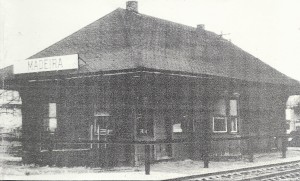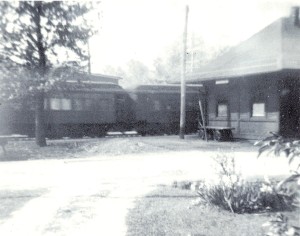By Regina Villiers. Originally published February 3, 1993 in the Suburban Life, added February 15, 2016.

The old Madeira train station, where the commuters waited, as it looked before it was remodeled. The bay window on the side is the spot where Brownie Morgan, as a child walking home from school, would see Mr. Ogler, the station master, sitting in a swivel chair doing his work.
Brownie Morgan’s lifelong fascination with trains did not end with his boyhood years. It continued when he grew up and started riding the commuter train, and it continues to this day.
The commuter train was a train that once ran regularly through Madeira.
The primary function of the commuter train was to carry workers who lived in the outlying areas, especially towns without streetcars, to their jobs.
The train left Loveland in the morning and returned on a schedule convenient to workers in industry. People boarded the train along the way at Branch Hill, Remington, Allendale, Madeira, a couple of stops in Madisonville, Oakley and Norwood, with Cincinnati being the last stop.
At the time that Brownie rode the train, and for several years after, he thinks, the train also ran on a half-day schedule on Saturdays. That run, finally, was ended by the five-day, 40-hour week.
Brownie doesn’t know when the commuter train came into being, but he started riding it around 1925 when he started his first factory job in Norwood when he was still quite young.
The people who rode the train from Madeira were mostly neighbors who would gather at the station every morning. In good weather, most of the waited outside. In cold weather, they’d go inside and huddle around the big, iron, potbellied stove, or take a seat on the benches that were fastened against the wall.
When the train stopped to pick them up, the conductor would get off to see that all were aboard. Then he’d hang out at an angle from the first step and wave a starting signal to the engineer, and off they’d go to Madisonville.
Brownie says he never did miss the train but often came close, especially after he learned about party fun and player pianos.
He rode the train with his friend, Pickle (Caro Knopp) who lived with his aunt two doors from the Morgans. “Lucky for Pickle and me,” Brownie said, “that the station was just down the street. We often came close to missing it, maybe within a few seconds.”
The riders were a friendly group, and they would soon get to know each other. Brownie still remembers them today.
There was Mr. Merkel, who lived on Euclid Avenue at Sanoma Drive. He’d wear his tall Shriner’s hat and would carry a tuba. He would need a whole extra seat space for his tuba, which he’d rest on the floor and steady with one arm.
Brownie supposed that Mr. Merkel was going to participate in parades on those days.
Miss Cleo Hosbrook’s father, Charles J. Hosbrook, also rode the train regularly. He was a surveyor and the village engineer. At times, he’d take his surveyor’s gear, including the tripod and tall measuring stick, on the train.
Brownie also remembers Ray Keys, who rode to work every day. Keys was the Morgans’ neighbor on Laurel Avenue, and later on Miami also, living where Friendly’s Restaurant now stands.
Keys had a crippled hand, and Brownie says the story went that his hand had been hurt in an explosion where he worked at Proctor and Gamble. He had saved his life by hanging outside a window. As a result, he was assured of a lifetime job and was given a better position at the firm.
The train had a relaxed atmosphere. Some people chatted with those around them. Others read newspapers or magazines. And some took the opportunity to nap.
Men and women, young and old, office workers, factory workers and some in salaried positions all shared the same coaches and seating positions. But there was never any disturbance that Brownie can recall. They were just neighbors going to work.
The monthly, round trip fare to ride the train cost $4.40.
Brownie can’t pinpoint just when the commuter train discontinued its runs, but he guesses that the availability of the automobile in increasing numbers killed the train. People started driving to work or using carpools.
Brownie did the latter. He started riding in a carpool for 50 cents a week. He could be picked up at his door and go non-stop to work. No more walking to and from the station. No more waiting for a train to appear.
The times they were a changing, to paraphrase Bob Dylan. And so the commuter train died.
Now, we have interstates, clogged with cars and traffic jams.
Brownie Morgan’s interest in trains still absorbs him. On his last visit to the bookmobile, he discovered a book, “The Big Book of Real Trains,” by Walter Retan. He recommends it to those wishing to expand their knowledge of trains, from the horse-drawn cart over wooden rails, down to the monorail era.
